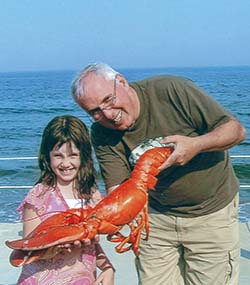 |
 |
| current issue |  | past issues |  | send a letter/news |  | address update |  | advertise |  | about us |  | alumni home |
In Memoriam
|
John A. Lindsay '70, '83G
He made a career of protecting the oceans he loved. By Chelsea Conaboy '04 |
|
 On their first date in 1966, John Lindsay '70, '83G and Betty Lausier went to the shore. Before that day, Betty had never seen the ocean. After, her life would be shaped by it. The ocean was Lindsay's passion, born of boyhood days spent on Wells Beach in Maine and exploring nearby tide pools. He was a gregarious Irishman with an infectious smile, she says. "I couldn't help but love it, too."
On their first date in 1966, John Lindsay '70, '83G and Betty Lausier went to the shore. Before that day, Betty had never seen the ocean. After, her life would be shaped by it. The ocean was Lindsay's passion, born of boyhood days spent on Wells Beach in Maine and exploring nearby tide pools. He was a gregarious Irishman with an infectious smile, she says. "I couldn't help but love it, too."
Lindsay, who died on Feb. 13 of mesothelioma, would build a career dedicated to studying and protecting ocean sites around the United States, the last stage focused on a small group of islands about 200 miles from mainland Alaska, where life revolves around the sea. "He really felt that he fulfilled his life's dream," Betty Lindsay says.
The couple was married with two children, Christine and Cris-Jon, before he graduated from UNH. Early on, Lindsay was a taxonomist for the marine lab at Normandeau Associates in Portsmouth and then worked a stint in southern California. The family returned to Durham, where Lindsay started his own firm, often hiring young marine scientists from the university, and completed his master's degree, focusing part of his studies on farming clams in New England.
Lindsay spent much of his career spearheading environmental restoration projects for the National Oceanic and Atmospheric Administration, work that again moved the family to the West Coast. Among the years-long projects he helped to lead—some are ongoing—were the cleanup of mercury contamination in Texas' Lavaca Bay and the hunt for radioactive waste dumped in Massachusetts Bay.
Lindsay was a problem solver, adept at bringing disparate government, community, and commercial interests together to act on a plan, says Alyce Fritz, who worked with him at NOAA's Office of Response and Restoration in Seattle. A self-described crusty New Englander with a soft spot and a laugh that put people at ease, "he had a lot of enthusiasm and perseverance," Fritz says.
The last 12 years of Lindsay's work were dedicated to the remote and rocky Pribilof Islands in the Bering Sea, where NOAA has worked to clean up more than 100 properties contaminated during the U.S. government's management of the fur seal harvest. The Lindsays embraced another mission there: documenting and preserving the history of the native people of the Pribilofs, their culture, and their connection to the land and sea. The couple compiled a genealogy and unearthed little-seen historical photos. Lindsay documented historical sites in partnership with the state of Alaska, sometimes helping to organize archaeological testing, says Joan Antonson, a state historian. A multimedia production facility he created to service the NOAA Pribilof office and the NOAA community produced 30 science-related films, including the award-winning documentary "People of the Seal," which he edited and produced.
As Lindsay grew sicker, the couple decided to move to Tennessee. Betty says her house there is nice, close to her daughter's. But she misses the ocean.
Return to In Memoriam
blog comments powered by Disqus
